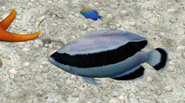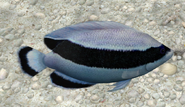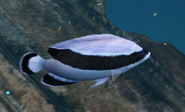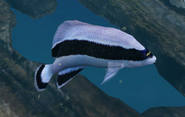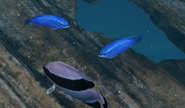← Black Pyramid ButterflyfishEndless Ocean Creatures
Endless Ocean 2 CreaturesRoyal Angelfish →
Humpback Grouper →
The banded angelfish (Apolemichthys arcuatus) is a species of small coral reef fish that appears in both Endless Ocean and Endless Ocean 2.
It is named for its distinct pattern - pearly-white scales with a slightly curved horizontal black bar that crosses its body. Its tail and anal fins also have smaller, matching bands.
In-Game
Marine Encyclopedia
Endless Ocean
Description
"These fish have narrow, elliptical bodies that are predominantly white with black banded lines running from the eyes to the rear of the dorsal fin. They can be seen year-round in caves and other areas.
Though the bands along the sides of the body, tail fins, and anal fins appear to be black, they actually have very thin white outlines.
These fish have inner ears that they use to hear certain sounds, but they also have organs on the sides of their bodies called lateral lines. While the lateral lines don't allow them to hear in the same way that humans do, they let the fish sense vibrations and movement in the water. In addition, lateral lines let them sense water currents and pressure, and also keep them from colliding with other fish while schooling."
Endless Ocean 2
Description
"It is primarily white with a black line running from above the eyes to the back of the tail fin.
On closer examination, a clear white border can be seen around this line and the black areas on its anal and tail fins."
[Finely-Tuned Senses]
"A fish senses sounds using two systems: the inner ear, located inside the ear, and the lateral line, a sensory organ running down its body. The lateral line is also able to sense changes in water currents and pressure.
When swimming in a group, the fish can detect minute changes in the currents, allowing it to swim without colliding with other fish."
Location
Endless Ocean
These are often seen under zoom-mode glows on the deck of the Navier in Ship's Rest. In the Great Aqua Cave, one can sometimes be seen under a zoom-mode glow on the ceiling of the White Room. They are also often found under zoom-mode glows on the sandy areas of the Underwater Ruins of Mo'ia Atoll.
Endless Ocean 2
These small fish are found under zoom-mode glows in the Deep Hole area, around coordinates A-2 SE, A-3 NE, B-2 S, and C-3 NW.
Behavior
These fish swim around slowly. They respond vigorously to being offered food. They may share their zoom-mode glow with another banded angelfish, or another species; for instance, in the first game, they are often seen with one or two sapphire devils while on the deck of the Navier, and are often seen with one painted and one warty frogfish when in the Underwater Ruins of Moi'a Atoll. Their trivia can be unlocked in the second game by feeding them.
Gallery
Notes
Real-Life Information
- The first and second game both mention the "lateral lines", a set of organs along the fish's sides that allow it to feel pressure and current changes in the water surrounding them. Lateral lines are present on many water-dwelling vertebrates, including all fish and many amphibians[1][2]. The lateral line is not a single organ; it is a set of smaller organs, called neuromasts, that are arranged in a row[1].
- Both games make note of the fact that, while the bands responsible for this fish's common name look solid black, they actually have white outlines that are brighter than the fish's base color. This is true[3][4]. Other common names for the banded angelfish that make reference to its physical appearance include bandit angelfish, black bandit angelfish, and Hawaiian pearlyscale angelfish[4][5][6].
- The banded angelfish is a moderately popular aquarium fish, but it is expensive due to its aesthetically pleasing looks and being gentle[5][7]. Unfortunately, it is also very delicate, and requires an expert level of care in order to thrive[8]. Part of the reason it is so hard to keep in an aquarium is that it is generally a species that prefers deeper waters, and so needs cooler temperatures than most standard tank fish can tolerate[4].
- Despite this fragile nature, banded angelfish have been bred in captivity before[7]. There is even a color variety without the dark band across the body, called "ghost bandit angelfish"[9].
- Another reason that the banded angelfish can be expensive is because it is found in a limited range in the wild; it is only found around the Hawaiian islands[10][11].
- Despite their relatively small home territory, the International Union for the Conservation of Nature has listed the banded angelfish as a species of Least Concern[12]. The population overall is large, and much of its range overlaps already protected areas of the ocean.
- The banded angelfish's diet consists mostly of sponges[11][13].
False Clown Anemonefish
• Yellowtail Clownfish
• Tomato Clownfish
• Yellow Clownfish
Sapphire Devil
• Starck's Demoiselle
• Goldtail Demoiselle
• Blue-Green Chromis
Threespot Dascyllus
• John Dory
• Singular Bannerfish
• Bicolor Angelfish
• Royal Angelfish
Threadfin Butterflyfish
• Bluelashed Butterflyfish
• Black Pyramid Butterflyfish
• Banded Angelfish
Humpback Grouper
• Dusky Batfish
• Mandarinfish
• Goldeye Rockfish
• Marine Betta
Harlequin Sweetlips
• Marbled Flounder
• Yatabei Blenny
• Rippled Rockskipper
• Red-Spotted Blenny
Bicolor Blenny
• Fire Goby
• Elegant Firefish
• Monster Shrimp Goby
• Watchman Goby
Singapore Prawn-Goby
• Blue-Spotted Jawfish
• Peacock Blenny
• Oblong Goby
• Yellow Clown Goby
Red-Spotted Goby
• Five-Lined Coral Goby
• Long-Spine Porcupinefish
• Yellow Boxfish
Whitespotted Boxfish
• Tiger Puffer
• Striated Frogfish
• Painted Frogfish
• Warty Frogfish
• Sea Robin
Southern Orange-Lined Cardinalfish
• Cardinal Fish
• Sea Goldie
• Stocky Anthias
• Cherry Grouper
Sunset Anthias
• Flying Fish
• Chub Mackerel
• Japanese Jack Mackerel
• Japanese Sardine
Antarctic Silverfish
• Capelin
• Dusky Rockcod
• Bald Notothen
• Slender Bristlemouth
References
- ↑ 1.0 1.1 Encyclopaedia Britannica (Lateral Line System)
- ↑ Lateral Line Co.
- ↑ Reeflex
- ↑ 4.0 4.1 4.2 Saltcorner
- ↑ 5.0 5.1 Maidenhead Aquatics
- ↑ Saltwater Fish
- ↑ 7.0 7.1 Frank Baensch Fish Culture & Photography
- ↑ ReefApp
- ↑ ReefBuilders
- ↑ Maui Ocean Center
- ↑ 11.0 11.1 Marine Life Photography
- ↑ IUCN Red List
- ↑ FishBase

